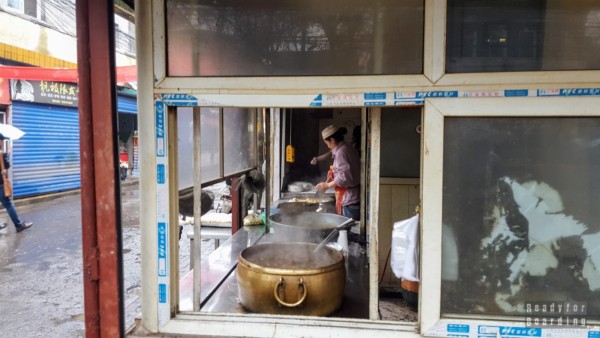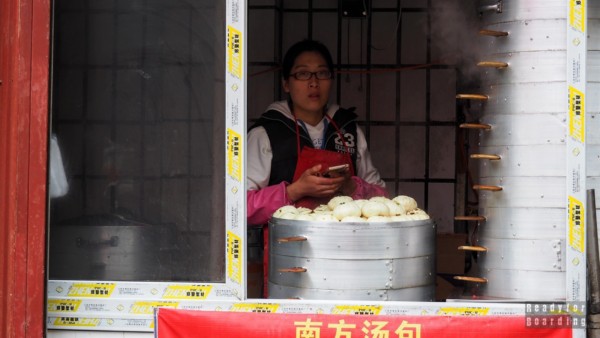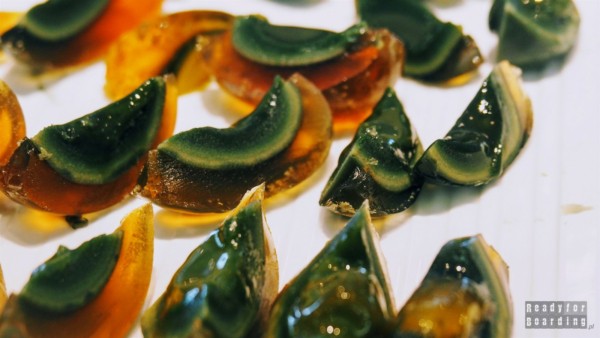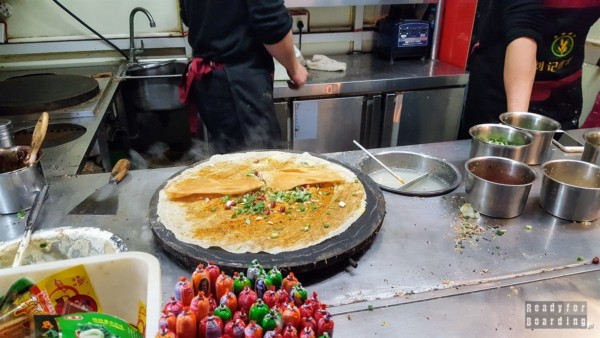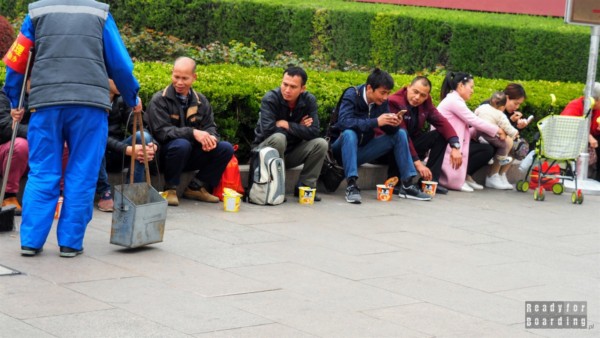Chinese cuisine is different from the typical Polish ‘Chinese’. Here you will find more than chicken in five flavors or egg rolls :) Today it will be simple, fatty, cheap and even sometimes tasty ;)
Let me warn you right away – this is not another culinary guide to China. We didn’t delve into the individual names, ingredients or preparation. In this post, we’ll give you a slightly different look at how to eat in China.
Table of contents
Tasty Chinese cuisine?
Chinese cuisine has never been one of our favorites. On the fingers of two hands we can count the number of times we ate Chinese food in Poland, and after each one I swore I wouldn’t touch Chinese food again. However, we believed we would find something different in China, not just rice or noodles with meat and vegetables. We also believed that we would not go hungry….
We wanted to eat a lot and try real Chinese food, not the typical “Chinese” from Poland. We read about steamed dumplings, fried snacks or pancakes, all freshly made on the streets.
Freshly made maybe, but how is it really with the freshness and quality of the products? Unfortunately, this remains a mystery…. we can only add from ourselves that you should forget about some decent sanitary conditions. Here, bars are governed by other laws, and the cheaper you want to eat, the fewer these laws are. We saw cheap, backwater eateries, and decent restaurants or Western fast food right next door.
Initially, we could not find each other completely. There were plenty of pubs near the hotel from which colorful neon signs shouted to us with nothing to say. Zero word in English! Everything fried until you smell old oil all over the street – that was our first impression, but fortunately, as time passed and we became more resistant to new culinary experiences, it turned out that it was possible to eat quite deliciously in the neighborhood – it just took some courage to approach, see and…. try to get along.
What do you need to know about?
Chinese cuisine (or perhaps we should use the word Beijing, since every region is different) is rather greasy – all meats, noodles, rice are mostly fried, dripping with fat. Fortunately, steamed dumplings or pampukhs are also very popular: they can be stuffed or not, sweet or salty. Definitely more digestible :) We also recommend soups with dumplings or noodles.
Local cuisine is dominated by meat, fish, seafood, pasta, rice, and of the vegetables, mainly cabbage. And that’s what bothered us the most – the lack of fresh vegetables. They appear only as a side dish in a sauce for meat. Even the ravioli, if you want vegetarian, the only option for filling is mushrooms and cabbage.
We really enjoyed the pancakes, such a’la pancakes, which are called jianbing. They are stuffed (beware!) with some kind of crispy pancake, lettuce, peanuts and sauce. Simple, and how delicious. Plus it was cheap as borscht – a piece cost about 6 yuan, and for picky eaters for an extra 2-4 yuan you could get the meat inside.
Forget about sweets, chocolate lovers this country is definitely not for you! There are confectioneries here, but they offer mostly sponge cakes with creams, whipped cream, some donuts…. generally poor.
Also, vegetarians will have a tough nut to crack. The cuisine is meat-based, the aforementioned pancakes, dumplings, pasta/rice with vegetables remain. The Chinese don’t really understand why they should give up meat, for them it’s just another Western vision.
What is worth trying? We’re in Beijing, so how about Peking duck? Unlike Greek-style fish, it’s actually a very popular dish in Beijing, and in many places you’ll see roasted ducks dripping with fat. Also interesting are, for example, 100-year-old eggs, fortunately in name only, but their appearance does not encourage feasting.
Of course, everything is eaten with chopsticks – in restaurants we have a choice of either wooden, disposable or reusable, straight from the sterilizers.
Where and how to feast?
During the trip we ate in many more or less interesting places. Here are some suggestions for you on what and where to eat, depending on what you feel like.
1. precautionary – immediately after landing, we were very overwhelmed and confused about what was going on here. So we took our first steps to the hypermarket, where we wanted to discern what and how. Market not just any market because Walmart and it’s 3 stories high.
This is also where we had our first meal in China – behind the cash registers was a canteen with several restaurants including one self-service type. There was nothing in English, but we could at least see what something looked like before ordering.
We took a lot of things a little at a time, and included “tomato soup” in Chinese (no, not Chinese paper soup). All in all, the soup alone would have been enough, but at least we could try different things.

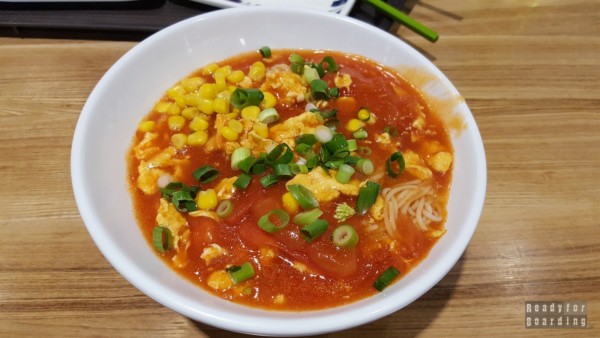
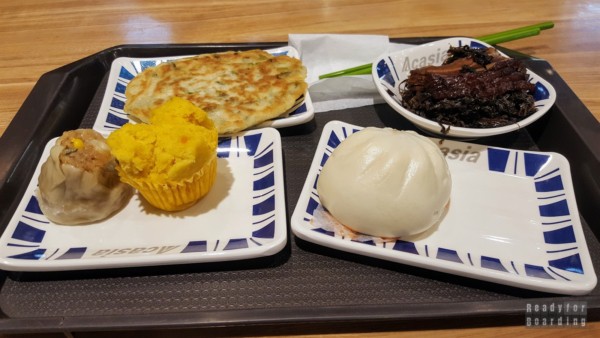
2) Western – if you don’t want to try Chinese food, you can easily find well-known chain stores here. In addition, we have already mentioned that there is a street in Beijing where you can try many new trends like ice cream in bubble wafers, churros, more or less fancy snacks.
3) Locally – near the hutong where we stayed overnight in Beijing, we saw a long queue once, which surprised us greatly. About 20 people waited at the entrance to the building, which seemed abandoned to us just yesterday. And this is the essence – places that look like closed, old establishments during the day, come to life in the evenings.
We decided to go there for dinner and see what kind of delicacies they have to offer. What did it turn out to be? The queue was standing behind the wings :) The cafeteria-looking place specializes in wings a dozen ways.
You choose as many as you want (2 pieces are included), and the gentleman waiter brings you a bucket with wings impaled on toothpicks. Then guess which flavor you ordered :)
Were there any over-sweetened ones? I would not say so, but the atmosphere of this place deserves to be recommended :)
4) On the run – our hit! The aforementioned pancakes/ pancakes/tortillas. It’s easy to miss them because sometimes it’s a small window, but it’s worth looking for :) It is cheap, quick to make, tasty and nutritious. It may be too spicy, so ask for less sauce to start with. The men pour out something like pancake batter, fry the pancake, put on the toppings and wrap it for the road. It also tastes good cold.
5) DIY – a novelty, or at least for us, because maybe somewhere in Poland you can already try a kitchen where you are the one doing the cooking :) This is a chain of restaurants where there is an electric stove on every table.
You choose a set of side dishes (meats, vegetables, pasta, etc.) and are given a pot of stock (sometimes two) in which you make your own food. You can control the stove, set the temperature, turn it off – you decide how cooked you want your food. Simple, and how much fun.
The chain of these restaurants is Xiabu Xiabu.
6) Take away – during our trip, we often indulged in long sittings at restaurants. Instead, we ordered take-out food and in the evenings we made up for the whole day (I know, unhealthy so in the evening :( ). In restaurants you can easily order food to take away, and that’s what we did. Near our first night in Beijing, we found a restaurant where a picture menu was available (rare!) so we could easily show our finger what we wanted.
Here we tried Beijing “Chinese” like rice or fried noodles with meat, vegetables, Peking duck. Here we also sampled a variety of appetizers and desserts (although these were mostly limited to fruit). Take away is very popular. in China: here we are referring to windows serving Chinese delicacies, open kitchens with pots and door-to-door trading.
This is where knowledge of Chinese already comes in handy, or you have to expect that you don’t know what you’re going to run into. That’s the lingo.
7) For rich – there are better and more expensive restaurants in Beijing. We were even in one. Well, okay, maybe it wasn’t super expensive, but we witnessed how such places function. First, automation and dish selection.
While waiting in line for a table, you are given a number, and the screen displays the numbers that will now take your seat, while waitresses walk around with pads, headphones and microphones. The menu is a book the size of a phone book! But for that there are pictures :) The dishes are plentiful, until it’s hard to decide on something.
It was the place where we waited the longest for food, but it’s worth it, because it was really tasty. Nevertheless, we still felt a bit like we were in a cafeteria, only that it was a better one. The smuggling of people and food was tremendous.
8) On the road – chinese soups! But not the kind we know in foil packaging. Here, stores have entire shelves stacked with boxes ready to pour boiling water. The choice of flavors, sizes, colors is really huge. Why the popularity?
Well, it’s a staple of any trip – no matter if the trip lasts an hour or five, Chinese soup must be there. At first we were shocked that on the stretch to the Great Wall, as soon as we started from the station, there was a line up to the boiling water faucet. Later we got used to it :) And yes, on every train you will get boiling water – it belongs like a dog’s kennel. The truth is that it is not healthy food, it is not outstandingly tasty, but for a moment you can feel like a native :)
As you can see, we have seen and tasted a lot, and this is still only a sort of proxy of what you can taste in Beijing. We are open to new culinary experiences, and will gladly taste something we haven’t eaten before, but it’s not a cuisine we’d like to live on for any length of time. Too fatty, not enough fruits and vegetables.
What are your impressions after tasting authentic Chinese cuisine? :)


